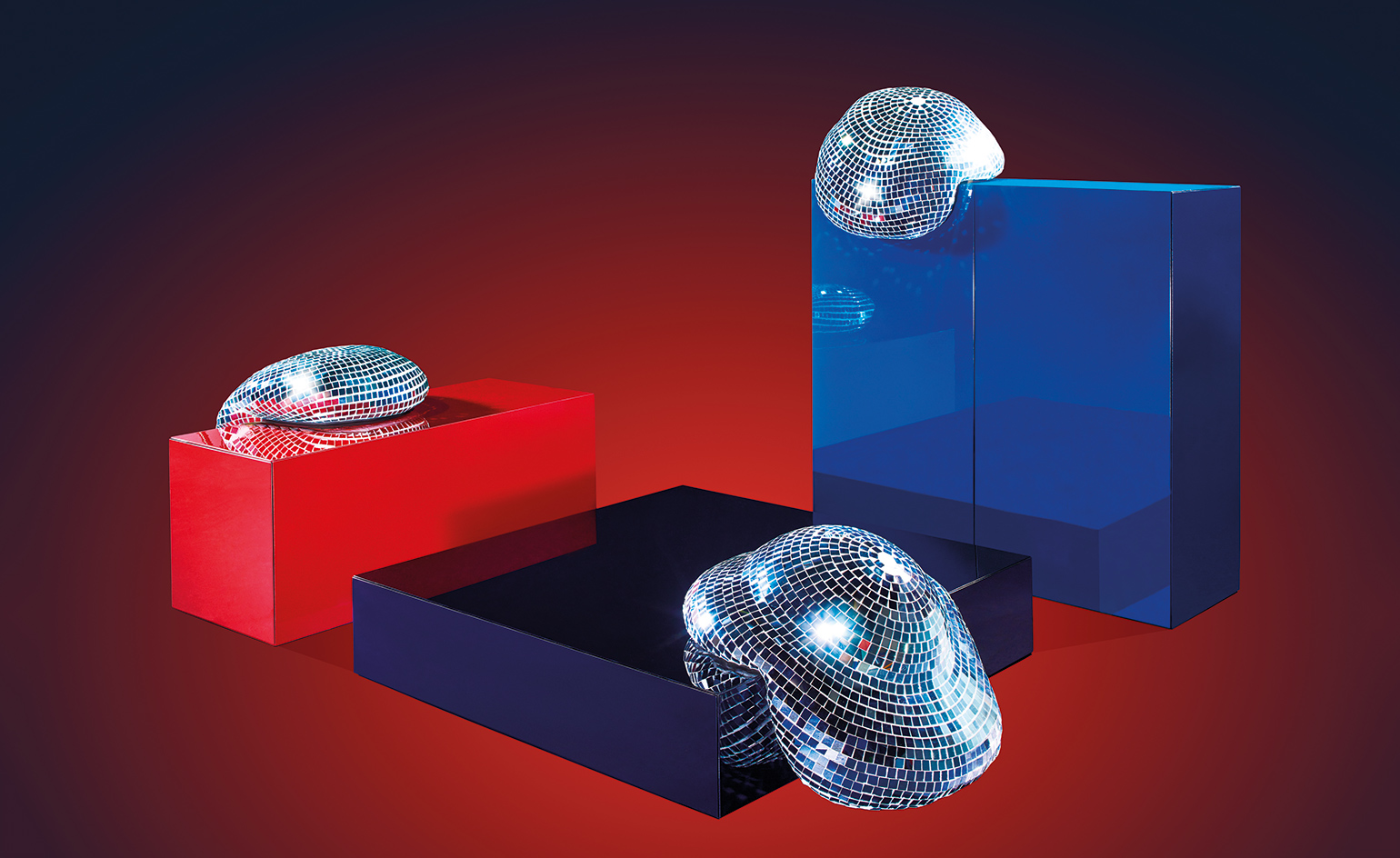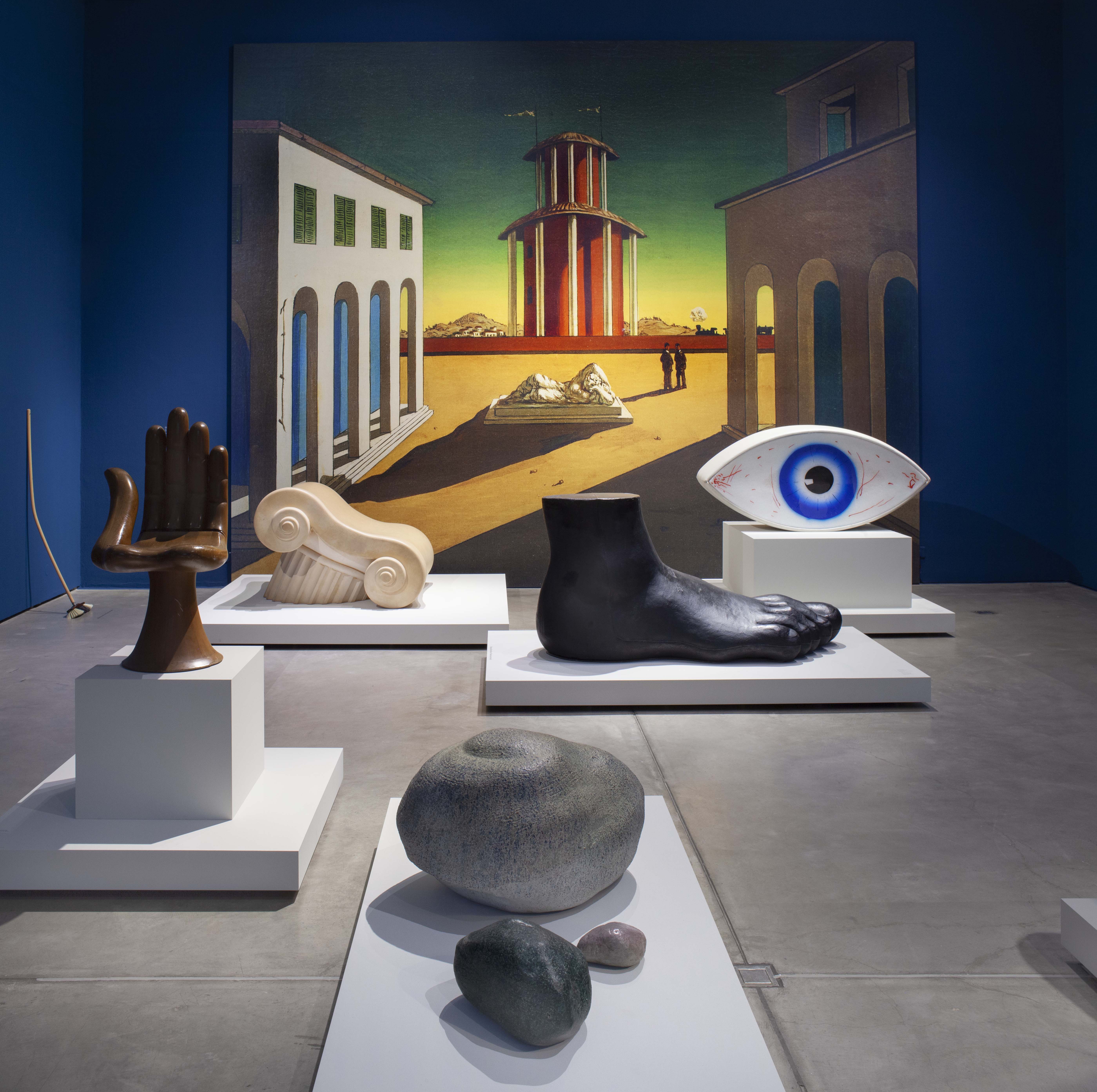Gufram gets its groove on with soul-powered seating at Salone del Mobile

When Gufram owner Charley Vezza first saw the deflated, Dalíesque disco balls created by Dutch artist duo Rotganzen, he knew they would be a perfect addition to the nightclub-inspired collection he was plotting.
Dancing had been on his mind since he found an old catalogue of contract furniture for discotheques in the Gufram archives. Dating from the 1980s, it featured a series of striking modular upholstered pieces. When Vezza showed it to the designers at Milan-based studio Atelier Biagetti, he kickstarted one of his company’s most exciting collaborations to date and a celebration of a particularly innovative space and time for Italian design.
‘There has been a growing interest in the Radical design movement in the past five years, and what it means for us today,’ says Catharine Rossi. A design researcher with a strong focus on the nightclub phenomenon, she is co-curator of a new show at Vitra’s Design Museum. ‘There has also been a growing interest in club culture, an area in which these Radical designers were active: the only spaces they actually built were discos,’ she adds. Nightclubs gave them space ‘to experiment and imagine... outside of commercial and corporate constraints’.

Dance Floor’ rug, by GGSV. Parisian designers Gaëlle Gabillet and Stéphane Villard of GGSV bring a dance-floor aesthetic with curvilinear, tubular designs that come in three sizes, 318 x 290cm; 290 x 180cm; and 300 x 198cm.
Disco design is an important part of Gufram’s history: the first such clubs appeared in Italy in the mid-1960s, around the time the company was founded, and some of the most iconic venues were designed by the same creatives that gravitated around its HQ – then something of an ideas factory – in Barolo, northern Italy. These architects were part of the Radical design movement, developed between Florence, Turin and Milan in the 1960s and dedicated to aesthetic innovation and experimentation. Radical architects Giorgio Ceretti, Pietro Derossi and Riccardo Rosso, designed some of Italy’s swankiest disco spaces, including Piper in Turin and L’Altromondo Studios in Rimini, a legendary club still operating today. Both were furnished with colourful seats produced by Gufram. The brand’s avant-garde approach later led to collaborations with the likes of architects Studio 65 to produce iconic pieces such as the ‘Bocca’ lips-shaped sofa.
Since 2011, Vezza and his team have been working to preserve Gufram’s heritage, while introducing new designers to build on the brand’s cult status. Delving into the company’s past is not an easy task: ‘It’s like having an immense puzzle to build, piece by piece, as we don’t have a traditional archive that we can work with,’ explains Vezza. ‘I always say that Gufram wrote the history of design without knowing it, so there was never a strong attention to documentation.’
The new collection is a playful take on an illustrious history, pulled off with typical Gufram exuberance. Each collaboration developed organically: first came Rotganzen, whose signature disco balls (originally created for site-specific installations) feature on a series of lacquered cabinets. Then Vezza turned to Alberto Biagetti and Laura Baldessari of Atelier Biagetti to reinterpret 1980s seating. ‘I immediately thought of them for two reasons: their innovative work on upholstered furniture, and the fact that they come from Romagna, an Italian region famous for its iconic nightlife,’ says Vezza.

The pair drew inspiration from the area’s clubs, such as Baia Imperiale and Coccoricò, but also reinterpreted elements of Gufram’s back catalogue into five new modular sofa designs, including a tartan and pink neon number, a large velvet offering, a soft blob of shimmering lilac, as well as a cluster of iridescent pouffes, and a golden leather sofa that can repeat and extend to create either a twisting or semi-circular composition. It is the first time that Gufram, a specialist in polyurethane foam, has produced upholstered furniture. The collaboration was ‘a meeting of minds’, say Biagetti and Baldessari. ‘We feel very close to Gufram’s cultural codes and references; it’s a company which moves very fast when it comes to innovation and research.’
The last piece in Vezza’s discotheque had to be a suitably groovy floor to showcase the furniture. Gufram head of product Axel Iberti commissioned Gaëlle Gabillet and Stéphane Villard’s Paris design studio GGSV to create a series of graphic rugs after coming across one of their dazzling installations at the Centre Pompidou. The ‘Dance Floor’ rugs were developed to invite dancers to stand in the middle and ‘do the freak’, the designers explain. ‘There is something excessive and very joyful in disco: it’s very Gufram.’
‘A furniture company speaks through its products, and our collections express a maximalist radical spirit,’ concludes Vezza. ‘This same spirit drives us to still be radical in all the choices we make every day.’
As originally featured in the April 2018 issue of Wallpaper* (W*229)

‘Stanley’ sofa, by Atelier Biagetti. A velvet sofa inspired by cinematic seats and limousine interiors. ‘Each sofa in the Disco Gufram collection is designed to be modular and expand fluidly into a space’, says designer Alberto Biagetti

‘After Party’ cabinets & tables, by Rotganzen. Dutch artist duo Rotganzen have placed their melting disco balls atop specially designed lacquered cabinets and coffee tables. The deliberately simple forms serve as pedestals to their ‘Gleaming Disco Drops’
INFORMATION
Disco Gufram will be at Wallpaper* Handmade from 17 – 21 April. For more information, visit the Gufram website
ADDRESS
Mediateca Santa Teresa
28 Via della
Moscova 20121
Wallpaper* Newsletter
Receive our daily digest of inspiration, escapism and design stories from around the world direct to your inbox.
Rosa Bertoli was born in Udine, Italy, and now lives in London. Since 2014, she has been the Design Editor of Wallpaper*, where she oversees design content for the print and online editions, as well as special editorial projects. Through her role at Wallpaper*, she has written extensively about all areas of design. Rosa has been speaker and moderator for various design talks and conferences including London Craft Week, Maison & Objet, The Italian Cultural Institute (London), Clippings, Zaha Hadid Design, Kartell and Frieze Art Fair. Rosa has been on judging panels for the Chart Architecture Award, the Dutch Design Awards and the DesignGuild Marks. She has written for numerous English and Italian language publications, and worked as a content and communication consultant for fashion and design brands.
-
 Put these emerging artists on your radar
Put these emerging artists on your radarThis crop of six new talents is poised to shake up the art world. Get to know them now
By Tianna Williams
-
 Dining at Pyrá feels like a Mediterranean kiss on both cheeks
Dining at Pyrá feels like a Mediterranean kiss on both cheeksDesigned by House of Dré, this Lonsdale Road addition dishes up an enticing fusion of Greek and Spanish cooking
By Sofia de la Cruz
-
 Creased, crumpled: S/S 2025 menswear is about clothes that have ‘lived a life’
Creased, crumpled: S/S 2025 menswear is about clothes that have ‘lived a life’The S/S 2025 menswear collections see designers embrace the creased and the crumpled, conjuring a mood of laidback languor that ran through the season – captured here by photographer Steve Harnacke and stylist Nicola Neri for Wallpaper*
By Jack Moss
-
 Ikea’s latest collection explores ‘the sweet spot between art and design’
Ikea’s latest collection explores ‘the sweet spot between art and design’Ikea’s Art Event Collection features objects by Sabine Marcelis, Daniel Arsham, Gelthop, Humans Since 1982 and Stefan Marx
By Rosa Bertoli
-
 Tracing the radical evolution of domestic interior design
Tracing the radical evolution of domestic interior designVitra Design Museum presents ‘Home Stories: 100 Years, 20 Visionary Interiors,’ a major exhibition that celebrates the power of interior design in the last century
By Ali Morris
-
 How 1920s surrealism impacted modern design
How 1920s surrealism impacted modern designA new show at Vitra Design Museum titled ‘Objects of Desire: Surrealism and Design 1924 – Today’ records how the avant-garde art movement influences design today
By Adam Štěch
-
 R & Company sets the table in new show on dining furniture
R & Company sets the table in new show on dining furnitureBy Elissaveta Brandon
-
 Stéphane Parmentier puts a graphic spin on hardware design with divine new collection
Stéphane Parmentier puts a graphic spin on hardware design with divine new collectionBy Siska Lyssens
-
 Sacred geometry and female artisans are at the heart of this NYC lighting brand
Sacred geometry and female artisans are at the heart of this NYC lighting brandBy Sujata Burman
-
 Loewe Craft Prize 2018 winner announced as Jennifer Lee
Loewe Craft Prize 2018 winner announced as Jennifer LeeBy Laura Hawkins
-
 Poltrona Frau debuts inaugural GamFratesi collection at Salone del Mobile
Poltrona Frau debuts inaugural GamFratesi collection at Salone del MobileBy Ali Morris